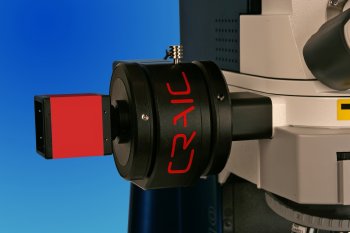Raman microspectroscopy is a non-destructive technique that allows you to identify and study materials, pharmaceuticals, semiconductors, biological samples and more. CRAIC Technologies has developed the CRAIC Apollo Raman microspectrometer to fit to most of the major brands of optical microscopes.
 CRAIC Apollo™ Raman microspectrometer to fit to most of the major brands of optical microscopes.
CRAIC Apollo™ Raman microspectrometer to fit to most of the major brands of optical microscopes.
The Apollo is a powerful solution, allowing you to collect Raman spectra from microscopic samples or microscopic sampling areas of larger samples. Now, with a single microscope you can image your samples and then measure the vibrational spectra of microscopic sample areas without further sample preparation or moving to another instrument. With the introduction of the CRAIC Apollo Raman spectrometer, CRAIC Technologies is proud to offer you another powerful tool for sample micro-analysis.
"CRAIC Technologies has been an innovator in the field of UV-visible-NIR microanalysis since its founding. We have helped to advance the field of microscale analysis with innovative instrumentation, software, research and teaching. We have seen the need for Raman microspectroscopy in addition to our current capabilities of UV-visible-NIR and luminescence microspectroscopy. Therefore, we created the CRAIC Apollo Raman microspectrometer with the power and flexibility to add to most of the major brands of optical microscopes" states Dr. Paul Martin, President of CRAIC Technologies.
"By incorporating Raman spectroscopy with optical microscopes, our customers have a very powerful tool at their disposal. It is also quite easy to use: you can simply analyze the same microscopic area of the sample under the same conditions without additional sample preparation or instrument alignment. Laboratory efficiency, accuracy and sample analysis throughput can therefore be dramatically increased."
The CRAIC Apollo Raman spectrometer is a self contained unit that features a cutting edge stabilized laser as an excitation source, a sophisticated optical interface to the microscope, a Raman spectrometer and advanced software for instrument control and data analysis. Different units are designed for use with different wavelength lasers and can be used in conjunction with one another. The idea is to give you a highly flexible Raman microspectrometer using the laser wavelengths you require to enhance your spectroscopic results.
These rugged, self-contained units can also be used with a CRAIC Technologies microspectrophotometer. With high sensitivity, durable design, ease-of-use, multiple imaging and spectroscopic techniques and the support of CRAIC Technologies, the CRAIC Apollo is more than just a Raman microspectrometer...it is a key component to your analytical solution.